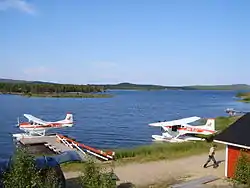Inari (village)
Inari is a population centre in the municipality by the same name in Lapland, Finland. It is widely known as the capital of Sámi culture.[1][2]
Inari | |
|---|---|
 | |
 Inari Location in Finland | |
| Coordinates: 68°54′20″N 27°01′40″E | |
| Country | |
| Region | Lapland |
| Municipality | Inari |
| Population (2014) | |
| • Total | 581 |
| Time zone | UTC+2 (EET) |
History
The village grew up along in a spot where the fast-flowing Juutua River empties into Lake Inari. As the centuries went by, the village developed into a robust and active market and trade centre. When the municipality of Inari was founded in 1876, the village became its centre.
The people living in Inari then were not, however, the first people to live in the village, as people had been living on the shores of Lake Inari for thousands of years before that. Several stone-age dwellings have been found in Vuopaja, on the edge of town near Siida, the Sámi Museum.[3]
Gallery
 Snow in Inari
Snow in Inari Hotel Inari
Hotel Inari Supermarket in Inari
Supermarket in Inari Inari Lake
Inari Lake
References
- HS: Inarin kirkonkylästä tullut saamelaisten pääkaupunki (in Finnish)
- Saamenmaasta, kulttuurista ja mytologiasta – Rantapallo (in Finnish)
- "History (of Inari)". Archived from the original on 2012-05-16. Retrieved 2007-05-09.
This article is issued from Wikipedia. The text is licensed under Creative Commons - Attribution - Sharealike. Additional terms may apply for the media files.